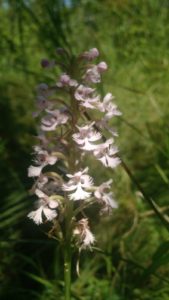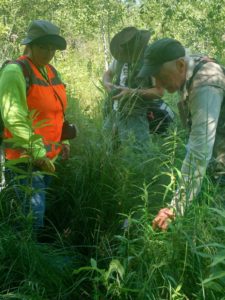If a canary is a health gauge for air quality in a coal mine, then one might consider our native temperate orchids a gauge for the health of our native plant communities.
Judy Larsen, spouse of the first Riveredge employee Andy Larsen, remarked that when they arrived to Riveredge 50 years ago, she observed a healthy orchid population, including a prominent grouping of Yellow Lady’s Slipper along the Milwaukee River. Yellow Lady’s Slipper has since been extirpated. White-tailed Deer are known to prefer this species, and the large herd size could be part of the reason behind its disappearance. Today, we have three known orchids on the property and are working to support these remaining species.
By researching our ‘canaries’ we hope to better understand the variables that individual orchid species need for success. We aren’t doing this alone but rather through collaborations with local partners so we may ultimately restore them to areas where they once thrived.
Through a Wisconsin Coastal Management grant, we have partnered with Sheboygan County, Stantec, The Chicago Botanic Garden, and the Minnesota Landscape Arboretum to setup long-term monitoring locations in coastal counties, propagate hundreds of individuals, and raise said individuals in a shadehouse until they are vigorous enough for out-planting. Partners outside of this two-year grant include The Smithsonian Institute, North American Orchid Conservation Center, The Ridges Sanctuary, and Illinois College.
Certain fungal communities work with orchid species through symbiotic relationships. In this way, the fungus is a surrogate root system for germinating seeds. Recognizing the importance of these relationships when returning a species to the landscape, our partner Illinois College is isolating unique fungal species associated with native orchids.
“It’s wonderful to see so many passionate researchers working together for the good of these species,” said Land Manger Matt Smith, “Through collaboration we can not only ensure the health of these species on our land, but in our region as well.”
In spring 2019, we will construct an Orchid Shade House, a nursery to raise native orchid seedlings for our immediate acreage and other natural areas that are suitable for temperate orchid reintroduction. We’re seeking the help of Citizen Science volunteers to document the health of orchid populations across our study sites, as well as anyone who has an interest in growing plants in the shade house. Through this project, you can help us discover the complex interconnected lives of Wisconsin plants and foster flowers that will be found by the next generation of explorers.


